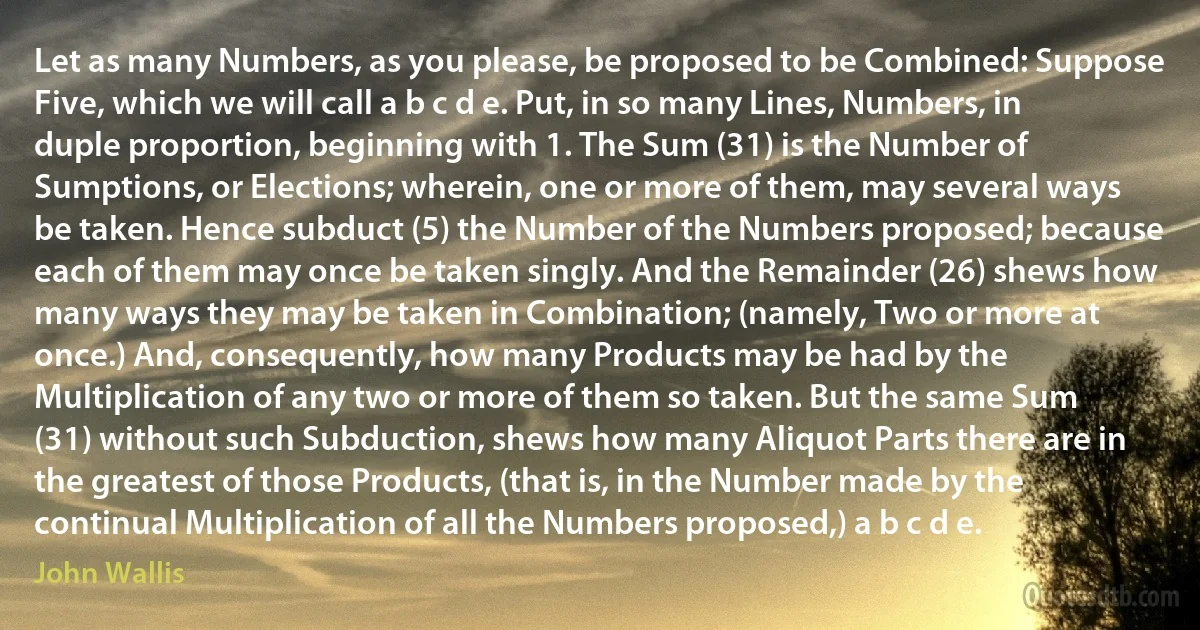
Let as many Numbers, as you please, be proposed to be Combined: Suppose Five, which we will call a b c d e. Put, in so many Lines, Numbers, in duple proportion, beginning with 1. The Sum (31) is the Number of Sumptions, or Elections; wherein, one or more of them, may several ways be taken. Hence subduct (5) the Number of the Numbers proposed; because each of them may once be taken singly. And the Remainder (26) shews how many ways they may be taken in Combination; (namely, Two or more at once.) And, consequently, how many Products may be had by the Multiplication of any two or more of them so taken. But the same Sum (31) without such Subduction, shews how many Aliquot Parts there are in the greatest of those Products, (that is, in the Number made by the continual Multiplication of all the Numbers proposed,) a b c d e.
John WallisRelated topics
beginning call five multiplication number once remainder suppose take parts waysRelated quotes
The number of syllables in the English names of finite integers tends to increase as the integers grow larger, and must gradually increase indefinitely, since only a finite number of names can be made with a given finite number of syllables. Hence the names of some integers must consist of at least nineteen syllables, and among these there must be a least. Hence "the least integer not nameable in fewer than nineteen syllables" must denote a definite integer; in fact, it denotes 111, 777. But "the least integer not nameable in fewer than nineteen syllables" is itself a name consisting of eighteen syllables; hence the least integer not nameable in fewer than nineteen syllables can be named in eighteen syllables, which is a contradiction. This contradiction was suggested to us by Mr. G. G. Berry of the Bodleian Library.

Bertrand Russell
The five great saints and many other leaders in the spirit world, including even Communist leaders such as Marx and Lenin, who committed all manner of barbarity and murders on earth, and dictators such as Hitler and Stalin, have found strength in my teachings, mended their ways and been reborn as new persons. Emperors, kings and presidents who enjoyed opulence and power on earth, and even journalists who had worldwide fame, have now placed themselves at the forefront of the column of the true love revolution. Together they have sent to earth a resolution expressing their determination in the light of my teaching of the true family ideal. They have declared to all Heaven and Earth that Reverend Sun Myung Moon is none other than humanity's Savior, Messiah, Returning Lord and True Parent. This resolution has been announced on every corner of the globe.

Sun Myung Moon
Senator Obama and I have had and argued our differences, and he has prevailed. No doubt many of those differences remain.
These are difficult times for our country. And I pledge to him tonight to do all in my power to help him lead us through the many challenges we face.
I urge all Americans ... I urge all Americans who supported me to join me in not just congratulating him, but offering our next president our good will and earnest effort to find ways to come together to find the necessary compromises to bridge our differences and help restore our prosperity, defend our security in a dangerous world, and leave our children and grandchildren a stronger, better country than we inherited. Whatever our differences, we are fellow Americans. And please believe me when I say no association has ever meant more to me than that.

John McCain
Money! Money in Oz!" cried the Tin Woodman. "What a queer idea! Did you suppose we are so vulgar as to use money here?"
"Why not?" asked the shaggy man.
"If we used money to buy things with, instead of love and kindness and the desire to please one another, then we should be no better than the rest of the world," declared the Tin Woodman. "Fortunately money is not known in the Land of Oz at all. We have no rich, and no poor; for what one wishes the others all try to give him, in order to make him happy, and no one in all Oz cares to have more than he can use."
"Good!" cried the shaggy man, greatly pleased to hear this. "I also despise money - a man in Butterfield owes me fifteen cents, and I will not take it from him. The Land of Oz is surely the most favored land in all the world, and its people the happiest. I should like to live here always.

L. Frank Baum
And at last we've got to the end of this ideal racecourse! Now that you accept A and B and C and D, of course you accept Z."
"Do I?" said the Tortoise innocently. "Let's make that quite clear. I accept A and B and C and D. Suppose I still refused to accept Z?"
"Then Logic would take you by the throat, and force you to do it!" Achilles triumphantly replied. "Logic would tell you, 'You can't help yourself. Now that you've accepted A and B and C and D, you must accept Z!' So you've no choice, you see."
"Whatever Logic is good enough to tell me is worth writing down," said the Tortoise. "So enter it in your notebook, please. We will call it
(E) If A and B and C and D are true, Z must be true.
Until I've granted that, of course I needn't grant Z. So it's quite a necessary step, you see?

Lewis Carroll
